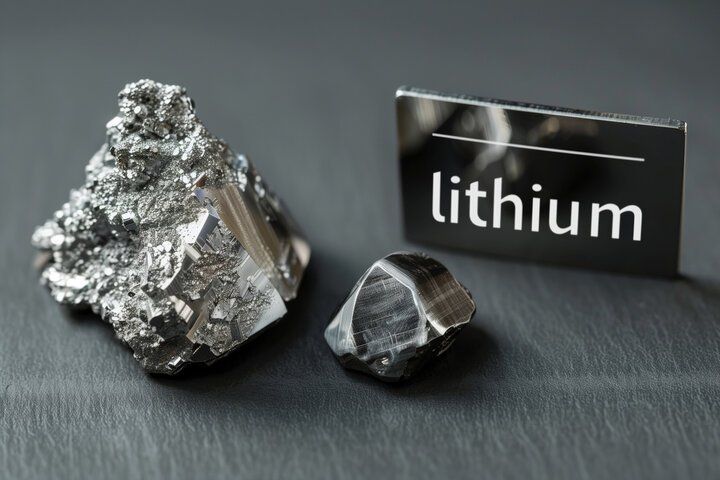What are lithium solar batteries? Most specialists agree that lithium batteries are the future of storage in the photovoltaic energy market. The expansion of electric vehicles has only given impetus to the thesis that this technology is destined to prevail. In this post we explain the advantages and disadvantages of lithium batteries, focusing mainly on their use for photovoltaic installations.

What are Lithium Solar Batteries?
Lithium batteries are a type of rechargeable energy storage device that uses lithium ions to transfer energy between electrodes. The idea of using lithium as an electrode material for rechargeable batteries was first proposed by Thomas Edison in 1909. However, it was not until 1991 that Sony brought the first commercial lithium battery to market. This was a lithium-cobalt dioxide battery for a Hi8 video camera with a capacity of 1200 mAh. Since then, the technology has been continuously improving, so today lithium batteries are commonly used in many portable devices (mobile phones, laptops, cameras, etc.). They are also used in electric cars and of course in solar installations.
The first lithium battery models were lithium metal batteries. This means they used metallic lithium (i.e. a network of lithium atoms) as electrodes. However, this type of battery had serious safety problems. The problem was that metallic lithium, being an alkaline metal, is highly reactive. Lithium not only reacts with oxygen but also with nitrogen, which is also present in the air. If lithium comes into contact with a reagent such as water, it ignites by itself. So, lithium batteries today no longer use metallic lithium. Instead, lithium is used in the form of ions, with which it is no longer able to react. Then, the correct designation of the current battery type should be “lithium-ion battery”. However, for simplicity, they are commonly called “lithium batteries”.
Pros of Lithium Batteries
One of the things that most quickly catches your attention about lithium batteries is their price, which is usually much higher than other types of batteries such as lead, gel or AGM. But as you understand their characteristics, you will understand why they are so expensive.
The list of advantages of lithium batteries is not exactly insignificant. They take the lead over other types of batteries in practically all the important aspects that must be taken into account in storage devices.
Pros
High energy density
For starters, their chemistry offers great density. This means that they can store a large amount of electricity in a compact device that is small in size and weight.
Long lifespan
They also have a charge depth that can reach more than 95% – lead acid batteries usually range from 50-70%. Besides, they have almost twice as many cycles as other types of batteries, which means that their useful life is much longer. Some manufacturers promise a lifespan of 20 years
High efficiency
In terms of efficiency, lithium batteries are also unbeatable. Other types of devices register 15-20% losses when charging or discharging them. But lithium batteries barely register 2%, all with an enviable recharge speed.
To all this, we must add a better adaptation to extreme temperatures. They operate even at very low temperatures. Even at -10 C energy efficiency remains 90%
Long Warranty
They require almost no maintenance and offer extensive guarantees – up to 10 years– compared to other model types of batteries.
BMS system
Admit it, now you understand why they are not cheap, right? Well, there is still the element that perhaps attracts the most attention in the latest models of lithium solar batteries. They include a BMS (battery management system). So, like a small computer, it is capable of monitoring the charging and discharging of the device automatically. In other words, they are smart batteries.

Cons of lithium batteries: Expensive and difficult to recycle
Today, the difficult recycling of lithium batteries is – along with their high price, which we have already mentioned – one of the main disadvantages of these systems. However, things are changing for the better.
Limited Recycling Rates vs. Product Benefits
To be fair, it should be said that lithium batteries make up for their low recycling rates – around 5% – with the qualities of the product, which, as we have seen before, manages energy more efficiently and is much more durable. So, it does not have to be replaced as often as other devices. That said, the environmental footprint of a lithium battery that reaches the end of its useful life is an issue that should not be overlooked, especially in these years, when we are going to see many lithium batteries that reach this point, including those of the first generations of electric vehicles.
Several factors point to the fact that the lithium battery recycling industry will experience significant development in the coming years.
Strategic Importance of Developing a Recycling Industry
On the one hand, there is a strategic factor: a good number of European and American manufacturers want to rely on domestic suppliers of raw materials to stop depending on third countries, especially in Asia and Africa. It is estimated that around half of the world’s cobalt production comes from the Democratic Republic of Congo, devastated by armed conflict and systematic violations of human rights. The United States has some important natural resources such as graphite and lithium in its subsoil. Europe does not, which is why encouraging the development of an industry for recycling materials found in lithium batteries is a crucial strategic step.
Economic Viability of Recycling
The value of materials such as cobalt, nickel or copper also makes their recovery make economic sense because of their profitability. Domestic electronic devices are a good source of this type of material, although the logistics of their recovery are difficult. This is not the case with batteries from electric vehicles or solar installations, which, although they have a lower proportion of valuable materials, are easier to locate and manage.
The importance of the environmental factor should not be ignored either, especially in Europe and the United States. Don’t forget that the renewable energy and electric vehicle industries are driven by growing social awareness of Climate Change. As the solar and electric vehicle markets continue to grow, so will concern about the environmental and ethical impact of lithium device production and manufacturers’ interest in ensuring their products are sustainable throughout the entire production chain, including at the end of their useful life.

How to choose a lithium battery?
Features to consider when choosing your lithium battery:
Battery capacity
It is measured in kWh (kilowatt hours) and represents the amount of electricity the device can store. In other words, it is the hours that you will have electricity when your solar panels are not producing. The capacities vary between 2.4 and 22.1kWh per unit. Also, many batteries offer the possibility of connecting multiple units to expand this capacity as your energy needs grow.
Battery power
This indicates the amount of electricity the battery can supply at any given time and is measured in kW (kilowatts). It reflects the number of electrical appliances that you can connect at the same time, depending on their power.
Battery discharge depth
This indicates how much of the battery’s capacity you can use before recharging it, to extend its useful life. Lithium batteries typically have a depth of discharge of between 80% and 100%, meaning that if you have a 10 kWh battery, you can use between 8 and 10 kWh of electricity.
Battery efficiency
In the process of transforming and storing energy in your lithium battery, a series of useful energy losses occur when charging and discharging the device. Lithium batteries stand out for their high efficiency (90-97%), minimizing these losses to 3%-10%.
Size and weight
Although most lithium batteries have a compact and lightweight design, it is important to choose one that is easily manageable, reducing the space you need for its installation.
Lithium battery lifespan
The lifespan of a battery is measured in cycles that include three phases: discharge, recharge and rest. For this reason, the more cycles a battery offers, the longer its lifespan will be.
Although this useful life will depend on your consumption needs, the production capacity of your solar panels, the depth of discharge or whether you have a connection to the conventional electricity grid, lithium batteries usually have between 4,000 and 6,000 cycles. This is approximately equivalent to between 10 and 16 years of useful life. However, some models offer up to 10,000 cycles, which would mean more than 27 years of useful life.
Compatibility with inverters
A fundamental element to remember when choosing your lithium battery is that not all are compatible with any solar inverter brand. So, when you opt for a certain brand of inverters, to a certain extent, you are also tying yourself to some specific battery brands.
Use that the battery will have
In addition to the technical characteristics, it is important to consider the specific use that you will give to the battery so as not to incur unnecessary expenses. For normal homes, it is recommended to opt for batteries with more life cycles, since batteries are charged and discharged almost daily. For a weekend or holiday home, a battery with fewer cycles may be more economical and sufficient.
Voltage
Lithium batteries can be classified according to their voltage. Thus, we differentiate between Low Voltage (LV) and High Voltage (HV) batteries. Although High Voltage (HV) batteries guarantee greater efficiency, the choice of one or the other type will depend largely on the inverter equipment you choose. If it is a hybrid inverter with a backup option, you will need an HV battery. For the rest of the battery-compatible inverters, each case must be studied to see if the LV or HV battery is of interest.
If you want to install lithium batteries for your company’s solar panels and you are not connected to the grid, the use of HV batteries is recommended, since they have a greater voltage range and three-phase connection.
Main brands of lithium batteries for solar systems
Generic Lithium Battery Manufacturers
On the one hand, there are generic manufacturers of lithium batteries. So, we can use these batteries with different brands of inverters. In this group, the BYD and Pylontech brands stand out. Both manufacturers offer storage solutions for both low voltage and high voltage.
- BYD batteries
They stand out for their scalability, capable of reaching 256kWh of capacity at low voltage and for their versatility of applications, being suitable for grid-connected installations, for the emergency power function (backup) and for installations isolated from the grid. - Pylontech batteries:
They have the same applications and offer the best quality-price ratio.
Batteries Designed by Inverter Manufacturers
On the other hand, we have lithium batteries developed by inverter manufacturers such as SolarEdge, Huawei and Enphase, specially designed to work with equipment from the same brand.
- Solar Edge:
In the case of SolarEdge, it has low voltage and high voltage batteries, which are modular and therefore scalable, with 100% depth of discharge for grid-connected installations and a backup function. - Huawei batteries:
The Huawei battery, also modular, in addition to being for self-consumption and the backup function, is also suitable for isolated installations. - Enphase:
For its part, the Enphase battery is, however, low voltage. It is also a modular system, but, unlike the previous ones, it is coupled in alternating current, with the battery itself carrying out the conversion thanks to the microinverters it integrates.
All-in-One Lithium Battery Solutions
Thirdly, some manufacturers offer “all-in-one” solutions. So, they integrate an inverter-charger into the battery to convert the energy they store into alternating current. These storage systems are compatible with any brand of inverter, as well as offering great versatility and scalability, and a backup function. We are talking about the following brands:
- Sonnen batteries
- Tesla Powerwall
- EP Cube from Canadian Solar.




Leave a Reply